By William C. Denfeld, Photos By William C. Denfeld
SOUTHPORT, NC - In medieval times, knights wore heavy gloves, or gauntlets, to protect their hands and wrists from damage in battle. These were noble times when challenges were issued to test the strength of one’s adversaries. To issue a challenge to a rival, a knight would remove a gauntlet and throw it down. An opposing knight, wishing to accept the challenge, would take up the gauntlet. Such a challenge has been issued by course architect P.B. Dye and his fine design, The Founders Club at St. James Plantation.
St. James Plantation is a gated residential community located near Southport, NC at the northern-most end of the “Grand Strand”, which includes the enormously popular golf destination of Myrtle Beach, SC. While physically close to Myrtle Beach, Southport and the surrounding area is a world apart. Words like “quaint”, “casual” and “quiet” are often used to describe this part of coastal NC, not far from Wilmington.
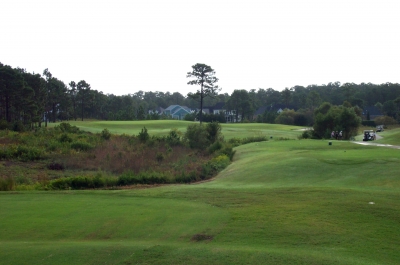 |
| This is a view of the fifth hole, whose green is divided by a solitary pine tree. |
Into this quiet, low country setting, the developers of St. James Plantation engaged P.B. Dye to build a golf course in 1991 and named it “The Gauntlet.” During the years since, the St. James Plantation community has grown to some 3,000 home sites with two additional golf clubs and numerous other amenities. The courses have developed property around them but the homes are set back from the course in most places and do not impact play.
In fact, all three golf courses at St. James Plantation have achieved the designation “Audubon Certified Cooperative Sanctuaries” by Audubon International. Only six other courses in NC carry such a designation. A fourth golf club is in development and is scheduled to open in the Spring of 2006. The Gauntlet gained a reputation through the years as a very stern test of golf and carries the highest slope rating on the Grand Strand at 151 from the tips.
After twelve years of operation, the owners closed the club in January 2003 for a one-month renovation. The club was reopened under a new name, The Founders Club, to honor the first property owners who settled in the St. James Plantation community in 1991. While the course is now known by a subtler name, the spirit of the original name can still be found around this challenging layout.
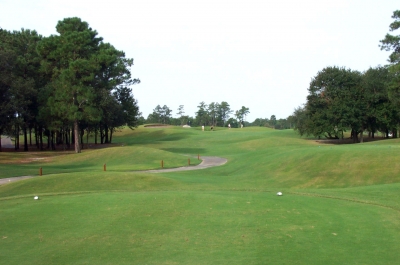 |
| The sixth hole is a drivable par 4 with many defenses between tee and green. |
Dave Kjome, Golf Course General Manager at St. James Plantation, shared his thoughts on this gauntlet thrown down by P.B. Dye. “The layout features all elevated greens with fairways that are pretty wide open, some unique designs from P.B. Dye,” Kjome stated. “It’s a tough, tough golf course that suits the name that they first gave it. It is still a brutal golf course, although some changes have been made to soften it up for the members.”
The course is different than many that carry such a lofty slope rating in that it presents wide, generous fairways that allow players to hit driver on most of the par fours and fives. Five sets of tees allow players of varying skill levels to find a course yardage that suits their ability. The challenge to the player comes with the approach shots to the greens. The holes generally get harder the closer the player gets to the greens. Many feature significant undulation surrounded by shaved drop offs that funnel errant shots into deep bunkering or water features. Chipping is often to a pin that is partly obscured by the slope of the green. Several greens are more than twenty feet above the level of the fairway.
The course opens with a pair of par fours that offer generous landing areas off the tee. The approach shot on number one is played to an elevated green fronted by a large bunker. More severe mounding surrounds the left and back of the green. The approach shot on number two is played from an undulating fairway that requires precision to find the putting surface, partly obscured by a pair of large pine trees and fronted by a deep bunker.
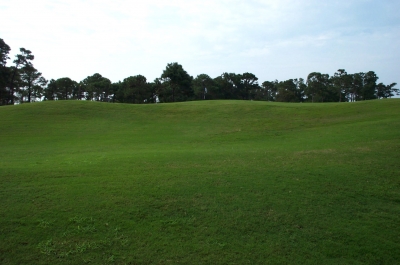 |
| The eighth green is perched high above the fairway, leaving a difficult chip to a pin only partly visible. |
The next three holes, a pair of par threes with a par five in between, contain the remaining design elements that define this layout. Number three is a par three of 188 yards to a green significantly raised above the tee boxes and falling off on all sides. Number four is a par five of 519 yards whose fairway becomes ever narrower as the player approaches the green. Trouble lurks with water left and bunkers and mounding right. The small green has significant undulation and is surrounded with challenges.
Number five is the second par three on the front and measures 221 yards from the tips. It features the largest green on the course, nearly fifty yards from front to back and nearly as wide. A large swale divides the green into two distinct areas with a single pine tree fronting the center of the green, ready to swat down a poorly played shot. Some fireworks have been spotted on this stretch of holes; however, according to Kjome, a member of the Founders Club carded an ace-birdie-ace score on these three holes in 2003.
The sixth hole is a drivable par four measuring 257 yards from the tips. The yardage masks the dangers awaiting the bold or the foolish. This challenge features a very small green perched atop a hill. Mounding and two well-placed bunkers obscure all but the top of the flagstick. Shots of any but the perfect yardage will often leave the player chipping to a still obscured green from well below the putting surface. Birdies are obtainable, but are well earned.
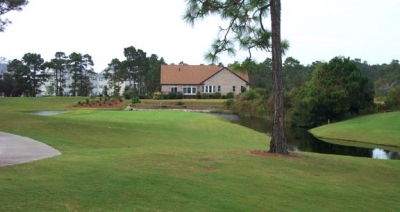 |
| The approach shot to the twelfth green must avoid the water and a large pine tree guarding the corner of the dogleg. |
The seventh hole offers a second shot over a marsh area to a raised green with shaved chipping areas all around. The eighth is a par five whose approach shot is played to a green some twenty-five feet above the fairway. Both of these greens feature the undulation that has been a constant challenge. The par-four ninth hole of 449 yards requires length and precision on the approach. The green is deep and narrow and slopes to the right into a large pond. A cautious player may choose to play short of the green and take his chances with a wedge.
The back nine begins with a par four; again requiring the player to hit a precise approach shot to a raised green fronted by a bunker. The eleventh hole, a par five, can be reached in two shots but is defended by water running nearly its full length on the right. The twelfth hole is a dogleg left par four of 403 yards played over a lake to a wide fairway. The green is not visible from the tee, making positioning difficult. The approach shot is played around or over several large pine trees at the corner to a green surrounded on three sides by water. Par, on what appears to be a short hole on the scorecard, is a very good score.
After negotiating the par three thirteenth and the challenging par five fourteenth, the player reaches the final four-hole stretch which truly symbolizes P.B. Dye’s gauntlet thrown at your feet. The fifteenth hole is a 466-yard par four that plays its full yardage and then some. The player must find the fairway off the tee, avoiding the large bunkers and water positioned both left and right. Drives in this rolling fairway may still present a problem as a side hill lie may make it difficult to execute the approach shot, often played into the wind. The green sits atop a hill some twenty feet above the fairway. Three large bunkers left of the green wait to collect the errant shot. The green is larger than it appears from the fairway. Par is an excellent score here.
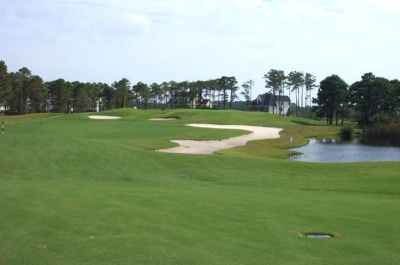 |
| The approach shot to the fifteenth green. |
Before leaving the plateau of the fifteenth green, the player heads to the sixteenth tee. Sixteen is a short par three of 145 yards played down off the hill to a very small green surrounded on three sides by water. Two bunkers, and an often-tricky wind, complete the defenses of this green. Don’t be fooled by the handicap designation of eighteen. A player must choose a club carefully and strike their ball with conviction . . . but you may wish to trade out that new ball for one you are not so fond of!
On to seventeen, a 440-yard par four. This hole may be one of the most difficult holes that an amateur golfer will find, not because of the distance but because it is hard to figure out. The fairway is of sufficient size but is hard to see from the tee. The player can see the 150-yard pole but can see little else except the marsh and water that completely surrounds the fairway and green. A player must trust the yardage and play a shot off the tee to the landing area near the 150-yard pole. The approach shot is played over the high brush and reeds of a salt marsh to a green that is completely hidden except for the flag. There is dry land short and left of the green but anything right or long is dead. Upon reaching the green, the player realizes what a small target the green represents. Four bunkers around the green add to the difficulty of this hole. Once again, the player must trust the yardage and hit good shots to be successful.
Dye’s final challenge is the par four eighteenth, measuring 387 yards. This final hole tests the skills and imagination of the player. The tee shot is played over a large salt marsh to a fairway running from left to right and away from the tee. Several large bunkers and mounds are visible from the tee as well as two checkered flags marking a water hazard on the far side of the fairway. The player must decide how much of the marsh to cut off with the drive while not being too sure how much dry land is available once the marsh is cleared. The daring player can aim almost straight for the green and let it fly. If successful, the player is left with a short approach to an undulating green. There is actually a fairly wide landing area around the 100-yard marker that is not quite such a heroic shot off the tee.
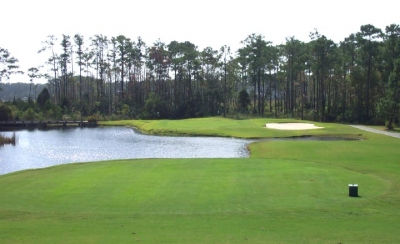 |
| The sixteenth green is well guarded by water on the front, l and behind. The bunker on the right will catch those who choose to bail out. |
A player, having taken up P.B. Dye’s gauntlet, may be tempted to throw down his own . . . golf glove in disgust, or may sit back and reflect on a great challenge accepted, hard fought and won. The Founders Club will test the skills and patience of those who take up the gauntlet, and reward those who conquer its many challenges.
Note: Check the links below for other stories on St. James Plantation, as well as other North Carolina destination reviews.
Details:
The Founders Club at St. James
Southport , NC 28461
Phone: (800) 247-4806
Website: www.stjamesplantation.com
Course Architect: P.B. Dye
Golf Course General Manager: David Kjome
Head Golf Professional: Rob Brothers
Par 72
Men:
Gold 7016/151 76.2
Black 6411/143 73.0
White 5852/137 70.6
Green 5218/130 68.5
Women:
Green 5218/141 74.4
Teal 4903/131 70.5
Rates:
The rates vary by time of year and range from $55 to $72 in the morning and from $45 to $55 after 12PM. All rates include your cart.
Other Information:
The course features a 10,000 square foot clubhouse, which includes a restaurant and snack bar as well as a fully stocked pro shop. The Founders Club, along with the other two courses at St. James Plantation, is a semi-private club and receives substantial play from the members. The public is welcome but early tee times are at a premium.
Pace of play is enforced with a timing device mounted on the cart steering wheel that gives players the elapsed time of the round along with the suggested course location for that time. The starter activates the clock at the first tee and loads the cart information into a hand-held device that allows the course marshals to monitor cart movement. Player’s assistants and a drink cart were available throughout the round. Players are encouraged to fill divots with sand and fresh bottles are available at several locations on the course. Sprinkler heads are marked for yardage and are outlined by orange paint to assist the player in locating them. There are also stone yardage plaques in the fairway at 200, 150 and 100 yards. All fairways have a black and white pole in the center at 150 yards that assists the player off the tee in lining up the drive. The carts are equipped with a pin position sheet with the greens divided into five zones. I would suggest purchasing a yardage book to play this course successfully.
Wind can be a factor on the course due to the proximity of the
| Related Links | Comments on this article? | |
|
Maryland National Golf Club Hollow Creek Golf Club Rocky Gap Resort PB Dye Golf Club in Ijamsville Whiskey Creek Golf Club |
E-mail Jeff Rendall, Editor: jrendall@golftheunitedstates.com |











